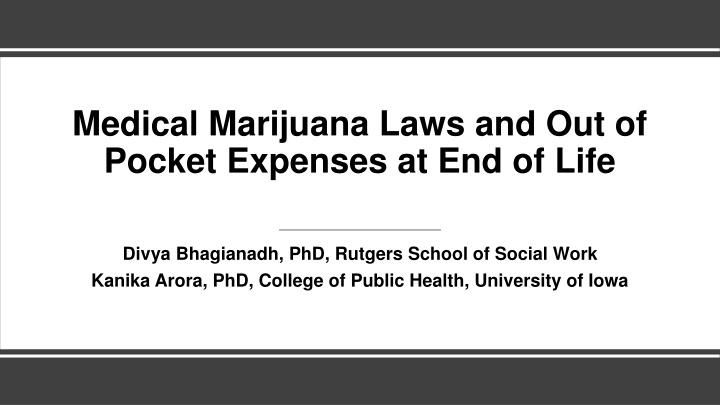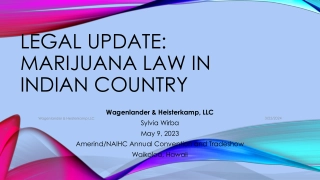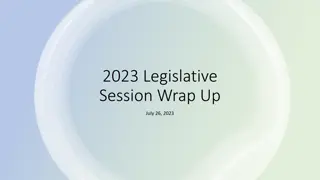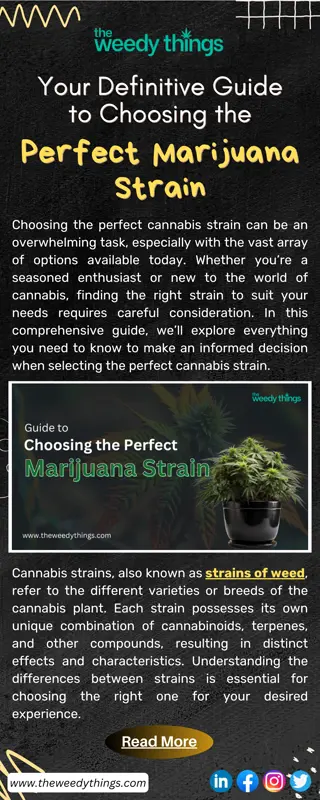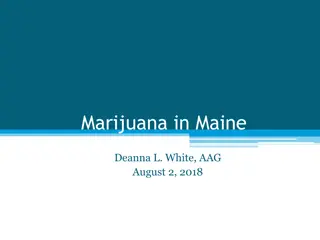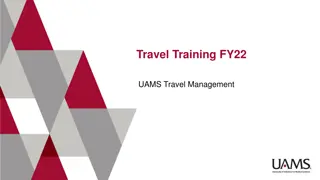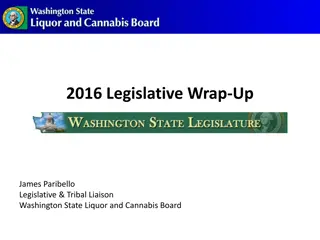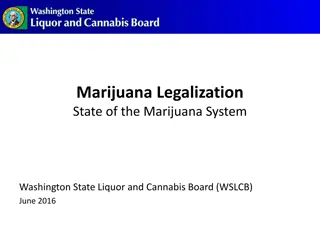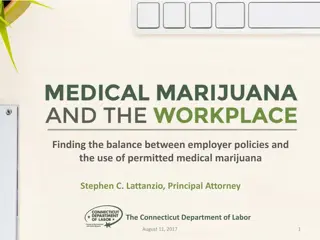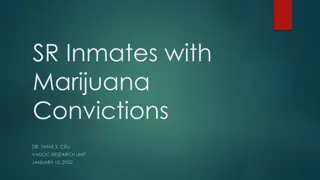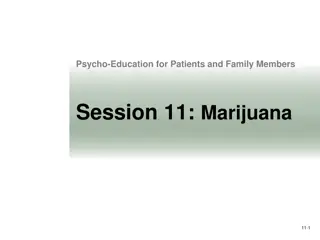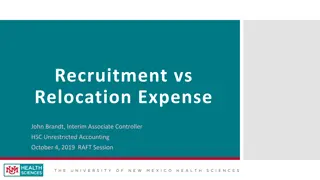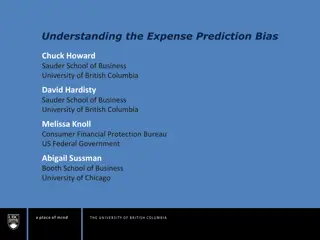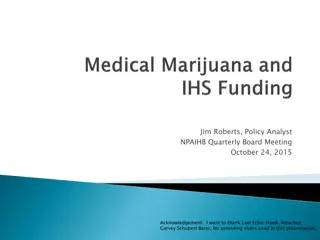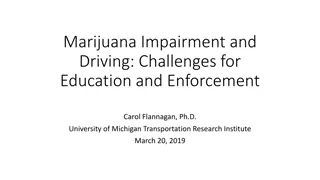Medical Marijuana Laws and Out-of-Pocket Expenses at End of Life Study
This study explores the impact of Medical Marijuana Laws (MML) on out-of-pocket expenses related to drugs and doctor visits at the end of life. Findings suggest regulatory and financial mechanisms influencing expenses. Data from geocoded state-level Health and Retirement Study interviews is analyzed to understand spending patterns and cost burdens faced by older adults.
Uploaded on Feb 17, 2025 | 0 Views
Download Presentation

Please find below an Image/Link to download the presentation.
The content on the website is provided AS IS for your information and personal use only. It may not be sold, licensed, or shared on other websites without obtaining consent from the author.If you encounter any issues during the download, it is possible that the publisher has removed the file from their server.
You are allowed to download the files provided on this website for personal or commercial use, subject to the condition that they are used lawfully. All files are the property of their respective owners.
The content on the website is provided AS IS for your information and personal use only. It may not be sold, licensed, or shared on other websites without obtaining consent from the author.
E N D
Presentation Transcript
Medical Marijuana Laws and Out of Pocket Expenses at End of Life Divya Bhagianadh, PhD, Rutgers School of Social Work Kanika Arora, PhD, College of Public Health, University of Iowa
Background High out-of-pocket (OOP) expenses during EOL (Kelley et al., 2010; Marshall et al., 2010) 43% decedents exhaust their non-housing assets in the last five years of life (Kelley et al., 2010) Spending on drugs among the top 3 contributors in the last year of life (Marshall et al., 2010) MML and reduction in prescription drug use among older adults, reduction in Medicare expenses on drugs (Wen & Hockenberry, 2018; Bradford & Bradford, 2017) MML can influence OOP expenses at End of Life (EOL), especially that related to drugs and doctor visits College of Public Health
Mechanisms Regulatory pathway Discordant legal status (Federal/ state levels) Non-coverage of medical cannabis & related expenses Dependence on Out-of-network providers for certification Increased OOP expenses on drugs at EOL Increased OOP expenses on doctor visits at EOL MML Clinical efficacy & safety pathway Mode of use (non-smoking is more expensive) Multiple doc visits/visits to multiple doctors due to concerns about the use of medical marijuana
Data & sample Geocoded state level restricted Health and Retirement Study (HRS) exit interviews (1995 to 2018) RAND HRS detailed imputations file for EOL OOP expenditures Sample restricted to >=65 years at the time of death No missing covariates (2,044 (15%) decedents excluded) Final sample size: 11,289 decedents College of Public Health
Outcome variables OOP expenses on drugs: On average, about how much did he/she pay out-of-pocket per month for the prescription medications in the last two years? Multiplied by 24 in the RAND HRS imputations file to reflect cost over two years OOP expenses on doctor visits: About how much did he/she pay out-of-pocket for doctor or clinic visits in the last two years? Log transformed OOP expenses in 2018 dollars College of Public Health
Key independent variable & covariates Key explanatory variable: Presence of MML Treatment states: States with an effective MML by June 2018; Coded as 0 prior to MML implementation and 1 thereafter Control states: States that did not pass an MML by June 2018; Coded as 0 through 1994-2018 (never implementers) Individual decedent level covariates Socio-demographics, functional limitations, comorbidities, duration alive from the last core interview Time-varying state-level controls State-level policies (recreational marijuana laws, prescription drug monitoring programs), health system- supply-side variables, variables indicating EOL intensity, state LTSS environment and economic environment College of Public Health
Empirical Strategy Difference in Differences (OLS regression models) ??? ??? ???????????= ?0+ ?1??????+ ?2????+ ?3 ???+ ??+ ??+ ??? Event study model Other robustness checks Models with and without time varying state level controls Callaway & Sant Anna CSDID estimates Subgroup analyses: number of qualifying conditions, cause of death, race, gender, place of residence College of Public Health
Results Log of OOP expenses Drugs Doctor visits Panel 1: No state level covariates MML 0.33** (0.11) 0.81 11,289 0.31* (0.14) 0.09 11,289 ap-value for joint F-test for pre-trends N Panel 2: With state level covariates MML 0.34** (0.12) 0.72 11,289 0.69* 1,991.93 0.42** (0.15) 0.04 11,289 0.73* 887.12 ap-value for joint F-test for pre-trends N CSDID estimates OOP expenses in tt state in pre tt period (2018 $) Clustered std. errors at the state level in parentheses; *p<0.05, **p<0.01, ***p<0.001 Both models control for individual level covariates. Panel 2 models also include time varying state level control variables. MML- Medical Marijuana Legalization ap-value for F-test for null hypothesis: the difference in collective pre-period trends between the treatment and control group is zero. College of Public Health
Event study estimates Event study models with all covariates College of Public Health
Heterogeneity by program characteristics Log of OOP expenses Drugs Doc visits Panel 1: Early adopting states MML >99% registered users are in these states 0.72*** (0.14) 6,614 0.88*** (0.24) 6,614 N Panel 2: Late adopting states MML 0.17 (0.29) 9,039 0.11 (0.21) 9,039 N Clustered std. errors at the state level in parentheses; *p<0.05, **p<0.01, ***p<0.001 All models control for all covariates. MML- Medical Marijuana Legalization ap-value for F-test for null hypothesis for testing pre-period trends was not significant for all models College of Public Health
Moderating effects: OOP drug expenses Log OOP expenses on drugs Panel 1: Race Whites Non- Whites MML N Panel 2: Place of residence 0.42** (0.16) -0.56+ (0.31) 9,309 1,980 Metro Non- metro 0.35 (0.21) MML N Panel 3: No. of qualifying conditions 0.43** (0.12) 5,292 5,997 Single qualifying condition 2-5 qualifying conditions MML N 0.44 (0.26) 3,470 0.38* (0.18) 6,174 Clustered std. errors at the state level in parentheses; *p<0.05, **p<0.01, ***p<0.001 All models control for all covariates. MML- Medical Marijuana Legalization p-value for F-test for null hypothesis for testing pre-period trends was not significant for all models
Key takeaways MML passage leads to an increase in OOP expenses for drugs and doctor visits at EOL MML associated with an increase of nearly USD 650 and 275 for drugs and doctor visits respectively in the last two years before death as OOP expenses for decedents in the treatment states. Evidence of cost shifting to patients Cost savings for Medicare & Medicaid (Bradford & Bradford, 2017, 2018) Differential impact reflects differential access to quality assured products Medical cannabis costs should be part of healthcare cost discussions 85% medical cannabis users conditions with substantial evidence of therapeutic effectiveness (Boehnke et al., 2019) College of Public Health
